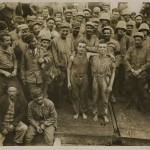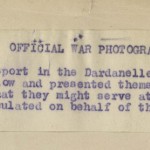Selected by Stephen Miller, Web Editor
What
Over 350 prints from the Official photographs of the Dardanelles Expedition, 1915-1916 are in the archival collection of Gen Sir Ian Standish Monteith Hamilton (1853-1947). Hamilton served as General Officer Commanding Mediterranean Expeditionary Force, Gallipoli, 1915, World War One. The photographs were supplied by Central News Agency.
Why
Luckily the prints in the archival collection are supplied captioned, as included. One of the most arresting things about these photographs is their clarity. The faces of not just the two boys working on the boat, but everyone in the group are clear and full of character. The headgear is a rich assortment of caps and hats including a few massive pith helmets and a fez. They suggest a variety or origins: Europeans and likely Asians and Africans? As for the boys, it is impossible not to wonder how they wound up on the boat. Their clothes and bare feet on rough planking suggest the clothes were donated. Yet the general good humour of the men posing is obvious. How real was the possibility that two such young men would wind up fighting in the campaign? The image throws up more questions than answers, but it is impossible not to be engaged by these men thrown together in an awful and ultimately unsuccessful campaign of this war. You feel you have almost stepped into the picture briefly.
Ref: Hamilton 7/12/218
www.kingscollections.org/catalogues/lhcma/collection/h/ha30-001/
More images from this collection can be seen on our online gallery on Google Cultural Institute

